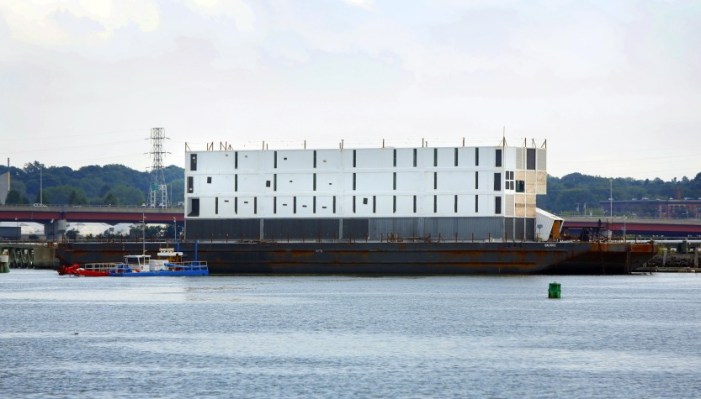Turns out fire safety concerns scuppered Google’s barge project last year, according to documents obtained by the WSJ under the Freedom of Information Act (FOIA).
The plan to use barges to host vast floating retail spaces for showcasing tech caused a frenzy of media excitement last year, mostly owing to initial mystery about what on earth the barges were for. Experimental labs for secret projects like Google hacking death? Nope.
The more mundane explanation was a plan for retail showrooms that could take Mountain View tech like Google Glass on tour. I guess that’s one way to try to drum up excitement for a wearable no one seems to want to wear.
In any case the plan floundered and appears to have sunk without a trace. One of the barges was sold for scrap this summer, the other has been moved out of San Francisco Bay to Stockton, without a permit to remain in the Bay.
So what exactly scuttled the floating retail showroom concept? Turns out there is a relatively mundane explanation for that too: health and safety concerns that Google and its contractor failed to salve.
Thing is, when you plan to cram a large number of people into a confined space that’s both floating on water and also packed with combustible substances there are understandable concerns about how to ensure safety in the event of a fire breaking out. Burning barges filled with people and fancy tech aren’t a spectacle anyone wants to witness.
Yet, according to emails obtained via FOIA, Google appears to have been in too much of a rush to take the necessary steps to reassure Coast Guard officials who were inspecting its San Francisco barge last year — causing work on the project to be suspended.
“The vessel’s design doesn’t incorporate certain fire safety features typically required,” the Coast Guard wrote in an email to Google’s contractor, Foss Maritime, in August 2013, adding: “We cannot determine if evacuation of disabled persons has been considered.”
“These vessels will have over 5,000 gallons of fuel on the main deck and a substantial amount of combustible material on board,” the Coast Guard warned in an earlier email in March.
In September the Coast Guard again warned of inadequate fire safety measures and suggested there was a risk of people having to jump overboard to avoid a fire.
Concerns about how Google would limit the number of people on board the vessel at any one time were also raised. And Google and its contractor were criticized for trying to seek quick approvals for the project, and for undertaking “significant work” without first gaining the full consent of the Coast Guard.
The project was halted in September 2013, and — it appears — abandoned entirely, given that one barge has been scrapped and the other is rusting in a California river delta.
What’s of most interest in this damp squib of a story is Google’s haste and apparent allergy to conforming to extant regulations. That and the secrecy applied to cloak a mundane aim.
The Coast Guard itself was asked to and signed nondisclosure agreements with Google, which contributed to the mystery about what the barges were for. To wit: “It is the easiest thing in the world for a man to look as if he had a great secret in him.”
In the end even Google got bored.
We’ve asked the company what it plans to do with its remaining hulk of slowly rusting metal and will update this story with any comment.
